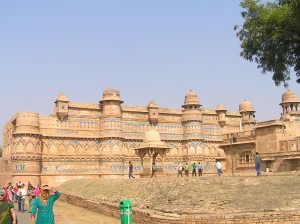Gwalior
Though I was born in Gwalior and spent many summer vacations at my grandparents’ home in Gwalior yet this was the first time I planned a visit to the fort besides the market to remember the good old days….
Gwalior is one of the big city in the state of Madhya Pradesh(central India) which has had a historic past dating back to 8th century.
According to the folk-lore a hermit by the name of “Gwalap” resided on the highest hill-top and cured Surajsen Pal Kachawa, a local chieftain, from leprosy. As a mark of gratitude this king named the city after the hermit’s name and hence the name “Gwalior”. He built a fort on the hill-top in around 727 AD.
The fort changed many hands since the Pal Dynasty to Mahmud Ghazni, Slave Dynasty, Tomar clan, Lodhi Dynasty, Mughals, Sher Shah Suri to Mughals again and then to Marathas and finally to Britishers. Later Britishers gave it to Shinde Kings as their protectorate. The Shinde family still exists known as “Scindias” and have ventured in Indian politics since last two generations with titles surrendered during Independence, retaining the “Jai Vilas Palace” as their property in Gwalior.
The taxi drivers strategically parked inside the Urvai gate of the fort take you inside the fort complex. The first building which still retains some of its original blue paint is the Raja Man Singh Palace. Some parts were destroyed in the British attack during the first war of independence in 1857.
This is a massive palace with seven floors of which few have been sealed to prevent access by wandering tourists. These floors are underground and housed several secret escape tunnels and hiding places in case of enemy attack. Other floors house the bedrooms, dancing halls, prayer rooms, library, bathing areas, cool rooms to escape summer heat, and lot many intriguing features like hollow telephonic pipe system in walls, cooling vents etc.
Another palace called as “Gurjari Mahal” belongs to a queen who belonged to a lower caste (Caste system was very rigid and in some parts of the country it still is). The palace is easily visible from the king’s bedroom balcony.
The taxi guy then takes you to a temple complex commonly known as “Saas-Bahu(Mother-in-law–Daughter-in-law) temple. The correct name however is “Sahastrabahu” (lord with thousand arms– Lord Vishnu) temple. The same complex has another temple of Lord Shiva. The interiors of both the temples are exquisite and intricate.
There is a “Jahangir mahal ” too which was used by the Mughal king when he was on a hunting trip. Some ruin of a British architecture building which was used as either a hospital or armory also survives the ravages of time.
There is yet another temple known as “Teli ka mandir“. None of the temples have any idol in them now. The grandeur can best be imagined by the intricate stone carvings everywhere.
West side of Fort wall is adorned by rock-cut statues of Jain monks. The main fort entrance is good for exploring the entire fort complex on foot as the steep slope is not easy for the taxis.
The whole complex is spread over a solitary hill and its tiring to explore which is why we could not complete the tour.
Other attractions of Gwalior are the sun temple and tombs of Tansen and his teacher Mohammed Ghous.
Jai Vilas Palace though still occupied by the descendents of Maratha king and open to public viewing is not well maintained by the family and is not worth wasting time and money.
Like most unplanned cities, Gwalior too is a hotch-potch of buildings mushrooming everywhere with dirty roads and no traffic sense. But it reminds me of the happy childhood spent in those streets with rides on horse-carts and the street food ….
And that is what the flavor of India is ! Go visit Gwalior and its fort which the Mughal king Babur described as a “jewel among the forts of Hind” and is also known as the “Gibraltar of India“.


See, these are of those I would kill to see. Just beautiful structures and I meant that.
LikeLike
See, these are of those I would kill to see. Just beautiful structures and I meant that.
LikeLike
Amazing architecture of man nice post friend:)
LikeLike
I would love to visit those works of art. I have always liked reading about India and watching film of it. I would visit it but don’t think I could live through the teaming streets full of people and activity without having a nervous breakdown. I visited NY City once and couldn’t wait until I got out!
LikeLike
haha..then come and stay with us. I will take you around for sight seeing.
LikeLike
Don’t say that! I may take you up on it! Actually, I could stay in a hotel if you want to play seeing eye :o)
LikeLike
That’s ok…problem is being in a transferable job we might be in a city where there is nothing of historic importance.
LikeLike
Oh wonderful to read a post on Gwalior! Years ago my dad an I.A.S officer was posted to Gwalior and saw man of the historical sites. Your lovely pictures rekindled my memories.
Thank you and regards 🙂
LikeLike
Gwalior is my birth place…i too have a lot of fond memories .
LikeLike